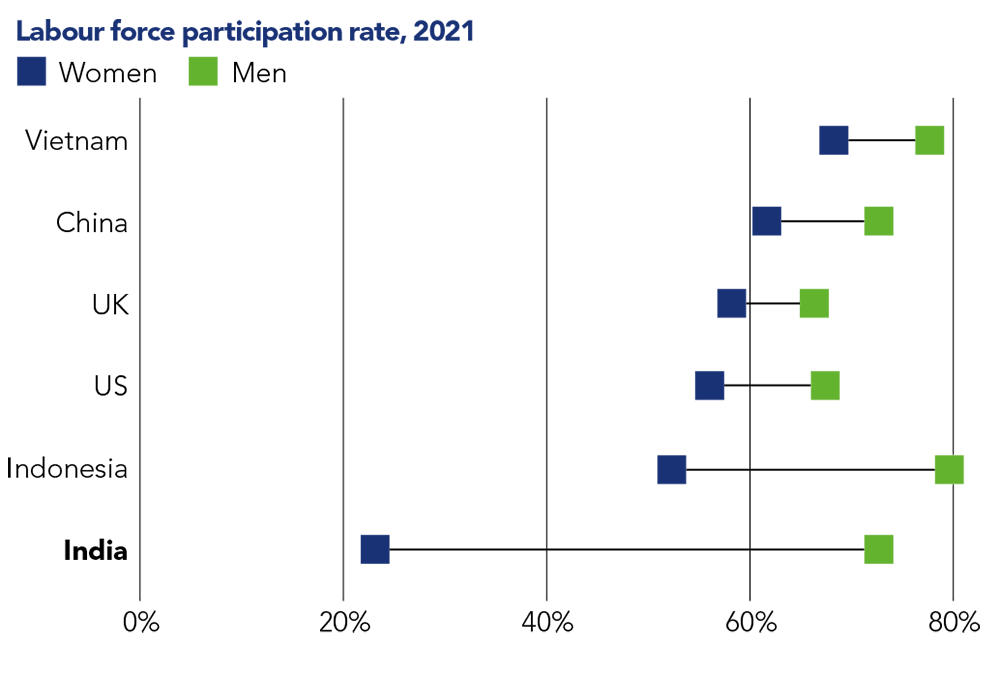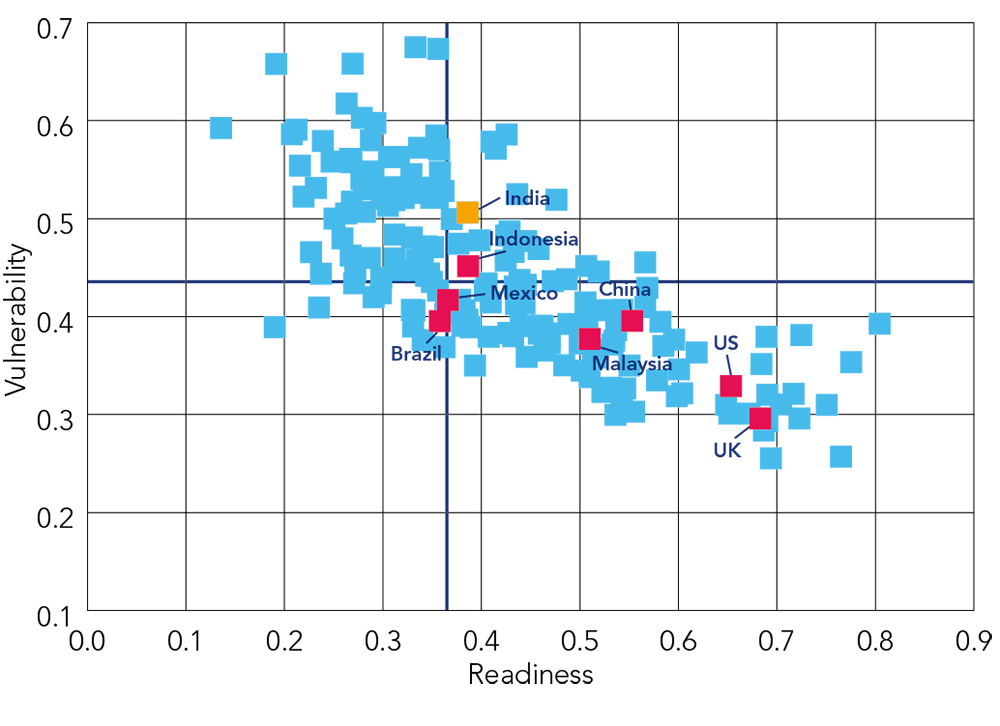India’s rapid economic growth over the last two decades has lifted millions out of poverty and contributed phenomenally to global human development. It is now the fifth largest economy in the world and will likely be the third largest in the next seven years, with its GDP more than doubling from the current US$3.3tn.
According to our analysis, India is forecast to add more than US$400bn to its GDP annually, a scale that only the US and China surpass1. India is poised to drive about a fifth of global growth in the coming decade.2
While growth has moderated slightly in recent months, the outlook remains strong, driven by many factors including India’s ‘demographic dividend’ (more than half of India’s population is under 30), an expanding middle class and rapid digitalisation.
Meanwhile, from an ESG perspective, the Indian government’s policy commitments around renewables, healthcare, financial inclusion and other sectors, give cause for optimism and present ample opportunities for companies to align with the UN Sustainable Development Goals.
However, India’s economic success has not yet resulted in an improved quality of life for everyone, and gender inequality and labour rights are ongoing areas of concern. Further economic expansion is needed to provide better education and improved healthcare, as well as access to banking services and the internet, to many more millions of people.
Companies face high exposure to climate change risks, both physical and transition, despite very low per capita energy consumption, and governance standards are sometimes lagging Securities and Exchange Board of India (SEBI) guidelines.
Against this backdrop, while the government of Prime Minister Narendra Modi is continuing to push ahead with reforms, it has set a delayed timeframe to achieve net zero of 2070.
ESG: risks and opportunity
While issues vary by company, at a country level, we consider climate change, water scarcity, labour rights, gender equality and access to basic services to be the most material environmental, social, and governance (ESG) risks and opportunity areas.
According to the World Bank and the UN’s International Labour Organization, overall female participation in the workplace is one of lowest in the world (less than 30% in 2021) and declining. India was ranked 140 out of 156 countries by the World Economic Forum (Gender Gap Report 2021) and is now one of the worst performers in South Asia, despite some improvements at senior and executive levels.3
Figure 1: India’s female participation rate lags behind

While labour disputes are still an issue to watch (and much flagged by ratings agencies), enlightened companies have a vested interest in ensuring good working conditions and positive employee relations. There is a trend in India towards increasing flexibility in favour of the employer; amended labour laws seek to reduce the administrative burdens on employers and bring more workers into the formal sector. A recent example being Karnataka’s new labour laws that allow 12-hour day and night shifts and an increase in allowable overtime. Companies typically employ a mix of contract labour and permanent employees depending on the skill level required, with lower skill jobs often given to contract workers.
While some sectors are further advanced on this topic (such as apparel), it is relatively new for others (such as the auto and consumer products industries). Risks of human rights abuses and poor working conditions increase at lower tiers of the supply chain, particularly when sourcing agricultural raw materials and metals. The Global Slavery Index flags that an estimated 8 in 1,000 people in India can be classified as being in the condition of modern slavery, compared to 4 in China, 6.4 in Indonesia and 6.3 in Malaysia. According to the World Bank, 1.7% of children aged 7-14 are involved in child labour (2019).
Despite huge growth that has lifted millions out of poverty, further economic expansion is required to deepen access to essential products and services. Notably, despite fast and widespread digital uptake, internet use in India hovers below 50% according to World Bank data with a marked gender gap (57% of men and 33% of women). This leads to both opportunities and challenges.
More than a fifth of Indians (aged over 15) are unbanked with women particularly affected. Government schemes provide a supportive backdrop, such as an initiative to guarantee a bank account for all, and the Aadhar scheme, which provides unique identification numbers to every individual.
In terms of access to health care, life expectancy at birth has increased from 62 years in 2000 to 70 years by 2020, yet many still lack access to services. All Indian citizens can get free outpatient and inpatient care at government facilities yet underfunding of the state system leads many households to seek care from private providers and pay out-of-pocket.
We consider climate change, water scarcity, labour rights, gender equality and access to basic services to be the most material ESG risks and opportunity areas.
Climate risks
Despite very low per capita energy consumption, India is the world’s third-largest greenhouse gas emitter. India’s economy is closely tied to natural resources such as agriculture, water and forests and is therefore highly vulnerable to increases in temperature. Research shows that with a 2°C to 3.5°C rise in temperature, India’s farmers may lose 9% to 25% of their net revenues, which may decrease the country’s GDP by 1.8% to 3.4%. The Notre Dame GAIN Index ranks India as more vulnerable and less ready than some of its peers (for example China and Malaysia).
Figure 2: India is more vulnerable to rises in temperature than peers

The government response has been mixed. It has set a net zero-by-2070 target as well as a target to reduce carbon intensity by 45% below 2005 levels by 2030. It also aims to create 500 gigawatts (GW) of renewable energy capacity by 2030. While India missed its 2022 renewable energy target, it continues to expand its renewable capacity, and has one of the fastest rates of uptake in the world.
However, despite policies to encourage the transition from coal to gas in various industries (such as the ceramics sector in Gujaret), the government continues to support the use of coal to ensure energy security and meet the fast-growing demand for power as India’s population rapidly increases. India has the second-largest coal pipeline globally and the draft National Electricity Plan4 projects another 26 GW of coal capacity will be installed by 2026-275. (Such priorities need to be seen in the context of a country where millions of people still do not have access to reliable electricity.)
Governance and recycling
India has one of the most developed informal recycling industries in the world. In terms of circularity6, however, many companies are in the early stages of establishing strategies. This is in part due to lower consumer demand and a less stringent regulatory framework. While there are initiatives (and some targets) around recycling and waste at factory level, most companies are yet to set targets around reduction of virgin materials (particularly plastic) in their products.
India was the first country globally to make Corporate Social Responsibility (CSR)7 mandatory by law with the 2014 amendment to the 2013 Companies Act, requiring companies with a net worth of more than 5bn rupees (US$70m) to spend 2% of their three-year annual net profit on CSR initiatives. This has led to increased spending on CSR, in addition to improved visibility and governance of these investments. Companies are required to set up board level CSR committees with at least three directors (one of whom must be independent).
In terms of wider corporate governance, while the SEBI guidelines have driven some improvements, few companies go beyond the minimum requirements. As well as a lack of diversity on boards, overall independence can be compromised by long tenures (more than nine years) and over-boarding. Other issues include related-party transactions (RTPs)8 without clear processes for seeking shareholder approval and escalating executive pay without appropriately stretching long-term incentives.
For more information on Global Emerging Markets Equity please click here.
1 Global Emerging Markets Outlook (hermes-investment.com)
2 India takes off? | Financial Times (ft.com)
3 Labor force participation rate, female (% of female population ages 15+) (modeled ILO estimate) – India | Data (worldbank.org). Explained: Why Indian Women’s Workforce Participation Is Still Considerably Low (indiatimes.com).
4 DRAFT_NATIONAL_ELECTRICITY_PLAN_9_SEP_2022_2-1.pdf (cea.nic.in)
5 India | Climate Action Tracker
6 Circularity means using plastics (or any resource) more efficiently by keeping the material in use for as long as possible, getting the most we can from the material during its use, and then recovering it to make new products.
7 In the Indian context, the term Corporate Social Responsibility (CSR) broadly refers to the work undertaken by corporates towards social and environmental causes.
8 A related-party transaction (RPT) describes arrangements and transactions between a publicly traded company and parties the company already has a pre-existing business relationship with.







